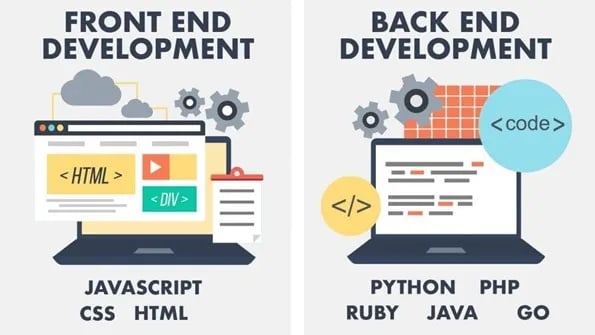Full stack development has gained significant prominence in software engineering, as it allows developers to work on both the front-end and back-end aspects of a web application. A full-stack developer is someone who possesses the skills and knowledge to handle all layers of the application stack, from the user interface to the database and everything in between. This comprehensive understanding enables them to build dynamic and interactive web applications that meet the demands of modern users.
When it comes to full-stack development, one of the critical considerations is the choice of programming languages. Different languages serve different purposes and have varying levels of popularity and community support. Understanding the languages commonly used by full-stack developers is crucial for aspiring developers, employers seeking to build efficient development teams, and even experienced professionals looking to expand their skill set.
Please keep in mind that the following discussion focuses on programming languages commonly used in full-stack development for web applications. It does not include languages and frameworks specifically designed for mobile app development.
Whether you are just starting your journey as a full-stack developer or interested in understanding the landscape of programming languages in this domain, this article will provide you with valuable insights. So, let's dive in and explore the diverse world of languages used by full-stack developers!
Front-End Development Languages
Front-end development focuses on creating the user interface and enhancing the user experience of a web application. It involves designing and implementing the visual elements that users interact with directly. Front-end developers utilize a combination of languages to achieve this, each with its own unique set of features and functionalities.
HTML
HTML (Hypertext Markup Language) is the backbone of every web page. It provides the structure and content of a website, defining the various elements such as headings, paragraphs, images, links, and forms. HTML is a markup language that uses tags to designate the purpose and formatting of different parts of a webpage.
HTML tags provide semantic meaning to the content, making it accessible and machine-readable. With HTML5, the latest version of HTML, new features like video and audio support, canvas for graphics rendering, and enhanced form controls have been introduced. HTML is considered a fundamental language for front-end development and is an essential skill for every full-stack developer.
CSS
CSS (Cascading Style Sheets) is responsible for the presentation and styling of web pages. It allows developers to control a website's layout, colors, fonts, and other visual aspects. With CSS, you can create responsive designs that adapt to different screen sizes, ensuring a consistent and visually appealing user experience across devices.
CSS works in conjunction with HTML, enabling developers to apply styles to specific elements or classes defined in the HTML markup. It provides a wide range of selectors, properties, and values to customize the appearance of web pages. CSS3, the latest version, introduced advanced features like animations, transitions, and flexbox layouts, empowering developers to create engaging and interactive user interfaces.
JavaScript
JavaScript is a powerful scripting language that adds interactivity and dynamic behavior to web pages. It enables developers to create interactive elements, perform form validations, handle user events, and manipulate the content of a webpage in real-time. JavaScript is extensively used in front-end development to create interactive user interfaces and enhance the overall user experience.
JavaScript has evolved significantly over the years, and its popularity has skyrocketed due to its versatility and extensive ecosystem. Modern JavaScript frameworks and libraries have emerged, providing developers with powerful tools to simplify complex tasks and build sophisticated front-end applications.
Examples of frameworks and libraries used in front-end development:
- React.js
Developed by Facebook, React.js is a popular JavaScript library for building user interfaces. It uses a component-based approach, allowing developers to create reusable UI components that update efficiently. React.js is known for its virtual DOM (Document Object Model) implementation, which optimizes rendering performance. - Angular
Developed by Google, Angular is a comprehensive JavaScript framework for building scalable web applications. It provides a robust structure for organizing code and offers features such as two-way data binding, dependency injection, and modular architecture. Angular follows the TypeScript language, a superset of JavaScript that introduces static typing and additional features. - Vue.js
Vue.js is a progressive JavaScript framework that emphasizes simplicity and ease of integration. It allows developers to incrementally adopt its features, making it suitable for both small and large-scale projects. Vue.js offers reactivity, component-based architecture, and a rich ecosystem of plugins and extensions.
Front-end development languages play a crucial role in creating visually appealing and interactive web interfaces. HTML provides the structure, CSS enhances the presentation, and JavaScript brings life to the user experience. Additionally, frameworks like React.js, Angular, and Vue.js provide developers with efficient tools and libraries to streamline the development process and build robust front-end applications.
Back-End Development Languages
Back-end development focuses on the server side of web applications, handling data processing, database management, and server communication. It involves building the logic and functionality that enable the front end of an application to interact with the server and perform various operations. Back-end developers rely on specific languages that excel in server-side programming and provide powerful frameworks for building robust web applications.
JavaScript (Node.js)
JavaScript, traditionally known for its front-end capabilities, has also made significant strides in the back-end development realm with the advent of Node.js. Node.js is a runtime environment that allows developers to execute JavaScript code on the server side, extending the language's reach beyond the browser.
Node.js provides an event-driven, non-blocking I/O model, making it highly efficient and scalable for handling concurrent requests. It has a rich ecosystem of modules and libraries available through npm (Node Package Manager), which facilitates rapid development and encourages code reuse. With Node.js, developers can build fast, scalable, and real-time applications, making it a popular choice for back-end development.
Python
Python is a versatile and beginner-friendly language that has gained immense popularity in the web development community. Known for its simplicity and readability, Python offers an easy-to-read and clean syntax as well as an extensive standard library, making it a powerful choice for back-end development.
Python's Flask and Django frameworks are widely used in building web applications. Flask is a lightweight micro-framework that provides flexibility and simplicity, allowing developers to have fine-grained control over their application's structure. On the other hand, Django is a full-featured web framework that follows the "batteries included" philosophy, offering robust features for rapid development and scalability. Python's rich ecosystem and supportive community make it an excellent choice for building complex and scalable back-end systems.
Ruby
Ruby is a dynamic, object-oriented language known for its simplicity and readability. It gained popularity with the Ruby on Rails framework, a powerful tool for building web applications. Ruby on Rails follows the convention-over-configuration principle, emphasizing sensible defaults and a structured approach to development.
Ruby on Rails provides a comprehensive set of libraries, tools, and conventions that streamline the development process. It promotes best practices and encourages developers to focus on building application logic rather than repetitive tasks. Ruby's expressive syntax and Rails' focus on developer productivity make it an attractive option for creating robust and maintainable back-end systems.
Java
Java is a powerful and widely-used language for building robust, enterprise-grade back-end applications. Known for its performance, scalability, and platform independence, Java has been a go-to language for large-scale systems and mission-critical applications.
Java offers a vast ecosystem of frameworks, libraries, and tools that simplify back-end development. It has a strong focus on object-oriented programming, providing features like classes, interfaces, inheritance, and polymorphism. Popular Java frameworks such as Spring, Jakarta EE (formerly Java EE), and Apache Struts offer comprehensive solutions for building scalable and modular back-end systems.
Spring
Spring is a widely adopted Java framework for building enterprise-level applications. It provides a lightweight and modular approach to development, allowing developers to focus on writing business logic rather than dealing with boilerplate code. The Spring framework offers features like dependency injection, aspect-oriented programming, and integration with various technologies, making it highly versatile and suitable for building complex back-end systems.
Spring Boot, a part of the Spring framework, simplifies the setup and configuration of Spring applications, enabling developers to create production-ready applications with minimal effort. Spring Boot's convention-over-configuration approach, combined with its vast ecosystem of extensions and libraries, makes it a popular choice for accelerating back-end development in Java.
PHP
PHP (Hypertext Preprocessor) is a widely-used scripting language for server-side web development. It is known for its simplicity, ease of use, and wide adoption in web applications. PHP offers seamless integration with HTML, making it easy to embed dynamic content within web pages.
PHP has a robust ecosystem of frameworks and content management systems (CMS) like Laravel, Symfony, and WordPress, which simplify the development of web applications. These frameworks provide features for routing, database interaction, authentication, and more, allowing developers to build scalable and feature-rich back-end systems in PHP.
Examples of frameworks and libraries used in back-end development:
- Express.js
Express.js is a minimalist and flexible web application framework for Node.js. It provides a straightforward set of features for building web servers and APIs. Express.js is known for its simplicity and extensibility, allowing developers to create scalable back-end applications with ease. - Django
Django is a high-level Python web framework that follows the model-view-controller (MVC) architectural pattern. It offers a comprehensive toolkit for building secure and maintainable web applications. Django's batteries-included approach, which includes an ORM (Object-Relational Mapping) layer, authentication, and administrative interface, enables developers to develop feature-rich back-end systems quickly. - Ruby on Rails
Ruby on Rails, often referred to as Rails, is a full-stack web application framework written in Ruby. It follows the MVC pattern and provides a convention-based approach to development. Rails emphasize developer productivity, offering features like scaffolding, automated testing, and seamless database integration, enabling developers to rapidly build powerful back-end applications.
Back-end development languages, such as JavaScript with Node.js, Python, and Ruby, empower developers to handle server-side operations, data management, and application logic. Coupled with frameworks like Express.js, Django, and Ruby on Rails, these languages offer powerful tools and libraries for building scalable and efficient back-end systems.
Trending or Emerging Languages
In the ever-evolving landscape of programming languages, new languages are constantly emerging and gaining traction among developers. These trending or emerging languages often bring unique features, improved performance, or better developer experiences. Exploring these languages can provide valuable insights and open up new possibilities for full-stack developers.
TypeScript
TypeScript is a strongly-typed superset of JavaScript that compiles plain JavaScript code. It introduces static typing, allowing developers to catch potential errors during development and enhance code quality. TypeScript offers features like type annotations, interfaces, and support for modern JavaScript features, enabling developers to write more robust and maintainable code.
TypeScript is increasingly popular in the JavaScript ecosystem, especially for large-scale applications. It provides better tooling, code auto-completion, and refactoring support, making it a favorite choice for full-stack developers. TypeScript is widely adopted in frameworks like Angular and is compatible with existing JavaScript codebases, allowing gradual adoption and easy integration.
Rust
Rust is a systems programming language known for its emphasis on memory safety, performance, and concurrency. It provides a modern and safe programming environment while maintaining low-level control over system resources. Rust's strong focus on memory safety helps prevent common programming errors like null pointer dereferences and buffer overflows.
Rust's borrow checker enforces strict rules around memory management, enabling developers to write highly efficient and safe code. It offers features like pattern matching, type inference, and a powerful package manager called Cargo. Rust is gaining popularity for building high-performance back-end systems, web servers, and even embedded systems where memory safety and performance are crucial.
ELM
ELM is a functional programming language specifically designed for front-end web development. It compiles JavaScript and emphasizes simplicity, reliability, and maintainability. ELM enforces a strict architecture called The Elm Architecture, which promotes a clear separation of concerns and a reactive approach to building user interfaces.
ELM's type system and immutability help prevent runtime errors and make code more predictable. It provides features like pattern matching, strong static types, and a friendly compiler that guides developers toward writing correct code. ELM's focus on simplicity and reliability makes it an excellent choice for building interactive and scalable front-end applications.
These trending or emerging languages—TypeScript, Rust, and ELM—showcase the continuous evolution of programming languages and offer unique features and benefits for full-stack developers. Exploring and adopting these languages can expand the range of tools and techniques available, opening up new possibilities and improving the overall development experience.
Choosing the Right Languages for Full-Stack Development
Choosing the right languages for full-stack development is a crucial decision that can impact the efficiency, scalability, and maintainability of your web applications. Several factors should be considered when selecting the languages to use, including skillset and personal preferences, project requirements, scalability needs, and ecosystem and community support.
Project Requirements and Scalability
Consider project requirements when selecting languages for full-stack development. Different projects have varying needs, such as scalability, performance, and complexity. For large-scale enterprise applications, languages like Java or C# offer scalability and robustness. For lightweight and fast applications, Python's simplicity and rapid development capabilities are suitable. Understand your project's requirements regarding traffic, data volume, integration needs, and performance to choose languages that align with those needs and provide necessary features and tools.
Ecosystem and Community Support
Consider the ecosystem and community support around a language. A strong ecosystem provides frameworks, libraries, tools, and resources that enhance productivity and simplify development tasks. Robust ecosystems like JavaScript, Python, and Ruby offer extensive community support, active development communities, and a wealth of open-source contributions.
Evaluate framework and library availability and maturity. Well-documented and actively maintained options can accelerate development and reduce the need to reinvent the wheel.



